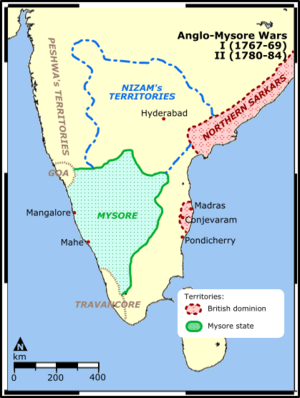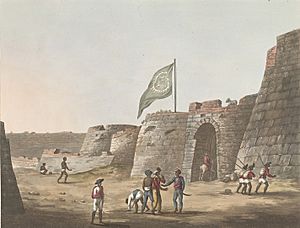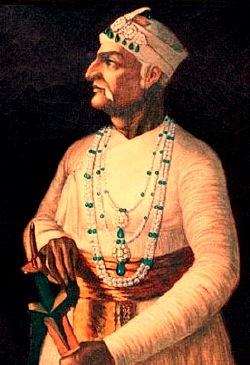First Anglo-Mysore War facts for kids
Quick facts for kids First Anglo-Mysore War |
|||||||
|---|---|---|---|---|---|---|---|
| Part of the Anglo-Mysore Wars | |||||||
 A map of the war theatre |
|||||||
|
|||||||
| Belligerents | |||||||
|
|
|
||||||
| Commanders and leaders | |||||||
|
|
||||||
The First Anglo-Mysore War (1767–1769) was a big fight in India between the Sultanate of Mysore and the East India Company. This war started partly because Asaf Jah II, the ruler of Hyderabad, wanted to stop the Company from taking control of some coastal areas called the Northern Circars.
Contents
Why the War Started
The 1700s were a very confusing time in India. The powerful Mughal Empire was breaking apart. Local rulers and governors started fighting for control of land.
In the 1740s and 1750s, French and British trading companies got involved in these local fights. By the Third Carnatic War (1757–1763), the British had strong bases in Bombay, Madras, and Calcutta. They had also weakened the influence of other European powers.
Near Madras, the British were closely linked to the Nawab of Carnatic, Muhammed Ali Khan Wallajah. His land surrounded Madras. Other major powers were the Nizam of Hyderabad and the Sultanate of Mysore. Mysore was a kingdom in the high plains, ruled by Hyder Ali, a strong military leader, since 1761.
All these powers tried to make deals with each other. They also tried to get the French and British companies to help them. The European companies wanted to control land or get money from local rulers who owed them favors. European armies were better trained, so even small numbers of their soldiers could defeat larger Indian armies.
British Goals and Nizam's Concerns

The British East India Company wanted a land route between its bases in Madras and Bengal. They aimed to control the Northern Circars, which were coastal areas. The French used to control these until the British pushed them out in 1758.
The British offered to pay the Nizam of Hyderabad a lot of money to rent these areas. But the Nizam said no. So, the British asked the Mughal Emperor Shah Alam II, who gave them rights to the land in 1765.
At the same time, the Nizam was allied with the Marathas. Both he and the Maratha leader, Madhavrao I, were worried about Hyder Ali of Mysore expanding his territory. They planned to invade Mysore.
When the British started taking over the Northern Circars in March 1766, the Nizam was very angry. He threatened the British in Madras. But he didn't have enough money for a war. So, he made a treaty with the British in November 1766.
Under this treaty, the British got four of the five Circars right away. They would get the fifth one later. In return, the British would pay the Nizam or give him military help. The British sent two battalions of troops to the Nizam. There were no rules about how many troops the Nizam could ask for, or how he could use them. The Nizam agreed to this treaty because he needed money, but he was not happy about British power.
Hyder Ali's Frustrations
There was also tension between Madras, Muhammed Jinnah, and Tipu Sultan. Muhammed Ali Khan Wallajah, who was allied with the British, was upset. Hyder Ali was protecting people who opposed him, like his brother and the son of a rival for the Carnatic throne.
Hyder Ali was also annoyed that the British had built a fort at Vellore. He had offered to make an alliance with the British several times, but they refused. They said it didn't fit with their treaty with the Nizam.
The First Anglo-Mysore War saw Hyder Ali do well against the British. He almost captured Madras.
How the War Happened
The war started in January 1767. The Marathas invaded northern Mysore, possibly expecting the Nizam to move. They went as far south as the Tunghabadhra River. Hyder Ali then negotiated with them. He paid them 30 lakhs (3 million) rupees, and the Marathas agreed to leave. By March, they had gone. This was a common way for the Marathas to get money.
The Nizam then marched towards Bangalore, with two battalions of British troops.
Changing Alliances
In May, the British commander, Colonel Joseph Smith, found out that Hyder Ali and the Nizam were making a deal. So, he pulled most of his troops back. Hyder Ali and the Nizam agreed to fight the British together. Hyder Ali would pay 18 lakhs rupees, and the Nizam would recognize Hyder's son Tipu Sultan as the ruler of the Carnatic once they conquered it. However, neither side fully trusted the other.
This new alliance led to an attack on a British outpost at Changama. The combined Mysore-Hyderabad army was much larger than the British force. But the allies were pushed back with heavy losses. Hyder Ali then captured Kaveripattinam. Colonel Smith retreated to Tiruvannamalai for supplies.
Hyder Ali attacked again at Tiruvannamalai on September 26, 1767, but was strongly defeated. Even though the monsoon season started, Hyder Ali kept fighting. He besieged Ambur in November 1767. The British commander refused bribes to surrender. When British relief troops arrived in December, Hyder Ali had to stop the siege.
Nizam Switches Sides

Hyder Ali's failures, along with British successes and secret talks with the Nizam, caused the alliance to break. The Nizam went back to Hyderabad and made a new treaty with the British in 1768. Hyder Ali tried to make peace with the British, but they refused.
In early 1768, the British in Bombay sent an army to Mysore's Malabar coast. Hyder Ali had a small navy there, but his ships deserted. The British easily took Mangalore in February.
This, and losing the Nizam as an ally, made Hyder Ali leave the Carnatic. He rushed to the Malabar coast. He sent his son Tipu Sultan ahead, and then Hyder Ali himself retook Mangalore and other ports from the British. He also punished local areas that had helped the British.
Fighting Continues in the Carnatic
While Hyder Ali was away, the British recaptured many places he had taken. They also convinced the Marathas to join the fight. A large Maratha army joined Colonel Smith in August 1768. They planned to besiege Bangalore.
But Hyder Ali returned to Bangalore on August 9. He attacked the Maratha camp on August 22, but was defeated. He tried to stop more British troops from arriving, but failed. The combined British and Maratha forces were too strong, so Hyder Ali retreated.
He tried to make peace, offering to pay money and give up land. But the British demanded more, including payments to the Nizam. Hyder Ali refused to deal with Muhammed Ali Khan Wallajah, whom he strongly disliked. So, the talks failed.
On October 3, Hyder Ali surprised a small group of Muhammed Ali Khan Wallajah's men at Mulabagilu. British troops arrived, but Hyder Ali's entire army surrounded a small British force. Another British officer, Colonel Brooks, tricked Hyder Ali by firing cannons and shouting "Smith! Smith!". Hyder Ali's troops thought Colonel Smith was arriving with a large army and retreated. This allowed the British to regroup. Hyder Ali attacked again but was pushed back with heavy losses.
The British blamed Colonel Smith for not defeating Hyder Ali, and he was sent back to Madras. Hyder Ali then besieged Hosur. When Colonel Wood came to help, Hyder Ali lifted the siege, went around Wood's army, and attacked his supplies near Bagalur. Hyder Ali captured supplies and arms. Colonel Wood was also replaced.
Hyder Ali's Final Push
Hyder Ali gathered more forces and went on the attack. In November 1768, he split his army and crossed into the Carnatic. He retook many small posts from the British. He even sent some British prisoners to Seringapatam.
After quickly taking control of much of the southern Carnatic, he marched towards Madras. This made the British send someone to discuss peace. But Hyder Ali insisted that the Nawab of the Carnatic be left out of the talks, so nothing happened.
Then, Hyder Ali surprised everyone. He took 6,000 cavalry and some infantry, and marched 130 miles (210 km) in three days to the gates of Madras.
This show of force made the British negotiate. Madras was almost undefended. Hyder Ali wanted an alliance where they would help each other if attacked. The British refused to agree to an offensive alliance. The Treaty of Madras was signed on March 29, 1769. It said that each side would support the other if attacked.
Key Battles
- Battle of Chengam (September 3, 1767)
- Battle of Tiruvannamalai (September 25, 1767)
- Siege of Ambur (November–December 1767)
- Battle of Ooscota (August 22/23, 1768)
- Battle of Mulwagul (October 4, 1768)
- Battle of Baugloor (November 22–23, 1768)
What Happened Next
Hyder Ali, feeling confident because of the treaty with the British, went to war with the Marathas in 1770. He asked the British for help if the Marathas entered his territory. But the British refused to help him.
Hyder Ali's wars didn't fully end until 1779. That's when the Marathas, Hyder Ali, and the Nizam made an alliance to fight the British together. This led to the start of the Second Anglo-Mysore War in 1780. This new war caused a lot of damage in the Carnatic. It also didn't solve the problems between Mysore and the British.
The conflict finally ended in 1799. Hyder Ali's son, Tipu Sultan, was defeated and killed. The Wodeyar family was put back in charge of Mysore, but they were now under British control.

